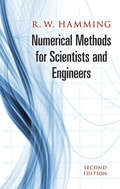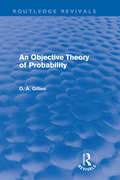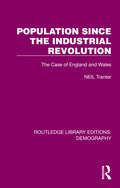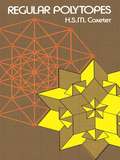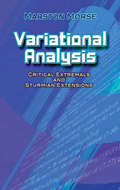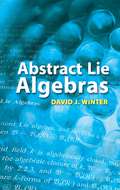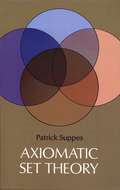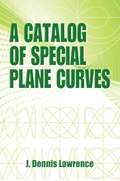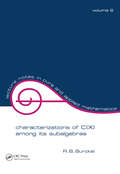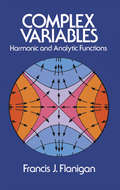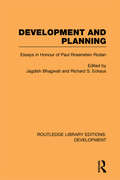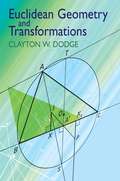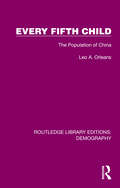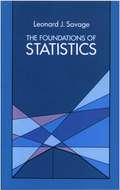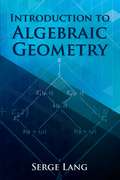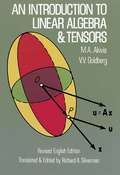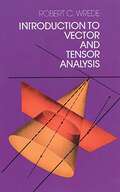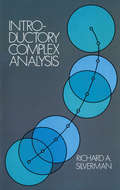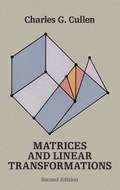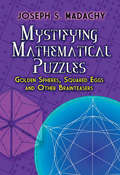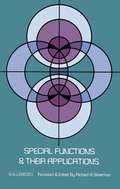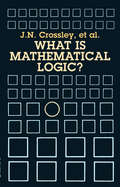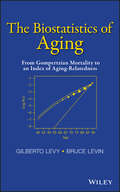- Table View
- List View
Numerical Methods for Scientists and Engineers (Dover Books on Mathematics)
by Richard HammingNumerical analysis is a subject of extreme interest to mathematicians and computer scientists, who will welcome this first inexpensive paperback edition of a groundbreaking classic text on the subject. In an introductory chapter on numerical methods and their relevance to computing, well-known mathematician Richard Hamming ("the Hamming code," "the Hamming distance," and "Hamming window," etc.), suggests that the purpose of computing is insight, not merely numbers. In that connection he outlines five main ideas that aim at producing meaningful numbers that will be read and used, but will also lead to greater understanding of how the choice of a particular formula or algorithm influences not only the computing but our understanding of the results obtained.The five main ideas involve (1) insuring that in computing there is an intimate connection between the source of the problem and the usability of the answers (2) avoiding isolated formulas and algorithms in favor of a systematic study of alternate ways of doing the problem (3) avoidance of roundoff (4) overcoming the problem of truncation error (5) insuring the stability of a feedback system.In this second edition, Professor Hamming (Naval Postgraduate School, Monterey, California) extensively rearranged, rewrote and enlarged the material. Moreover, this book is unique in its emphasis on the frequency approach and its use in the solution of problems. Contents include:I. Fundamentals and AlgorithmsII. Polynomial Approximation- Classical TheoryIll. Fourier Approximation- Modern TheoryIV. Exponential Approximation ... and moreHighly regarded by experts in the field, this is a book with unlimited applications for undergraduate and graduate students of mathematics, science and engineering. Professionals and researchers will find it a valuable reference they will turn to again and again.
An Objective Theory of Probability (Routledge Revivals)
by Donald GilliesThis reissue of D. A. Gillies highly influential work, first published in 1973, is a philosophical theory of probability which seeks to develop von Mises’ views on the subject. In agreement with von Mises, the author regards probability theory as a mathematical science like mechanics or electrodynamics, and probability as an objective, measurable concept like force, mass or charge. On the other hand, Dr Gillies rejects von Mises’ definition of probability in terms of limiting frequency and claims that probability should be taken as a primitive or undefined term in accordance with modern axiomatic approaches. This of course raises the problem of how the abstract calculus of probability should be connected with the ‘actual world of experiments’. It is suggested that this link should be established, not by a definition of probability, but by an application of Popper’s concept of falsifiability. In addition to formulating his own interesting theory, Dr Gillies gives a detailed criticism of the generally accepted Neyman Pearson theory of testing, as well as of alternative philosophical approaches to probability theory. The reissue will be of interest both to philosophers with no previous knowledge of probability theory and to mathematicians interested in the foundations of probability theory and statistics.
Population Since the Industrial Revolution: The Case of England and Wales (Routledge Library Editions: Demography #13)
by Neil TranterOriginally published in 1973, this book is an introduction to the study of population history since the Industrial Revolution and focuses on the experience of England and Wales. It provides both a comprehensive survey of the vast array of specialist literature and a thorough explanation of the sources and methodology of historical demographic analysis. Throughout special emphasis is given to the need to recognise that the historical pattern of population growth in England and Wales has been broadly similar to that observed elsewhere in Western Europe. The sources and techniques of historical demography are discussed and the general outline of population growth between 1688 and 1939 examined. The factors responsible for the dramatic increase in population growth during the late 18th and 19th Centuries are analysed as are the causes of the abrupt down-turn in rate of population following World War 1. The part played by population change in the development of the British economy and the impact of population change on society are also covered. By integrating the social and economic impact of population change with sources and methods, this text fills a gap and will be of essential reading to students in economics, sociology and social history.
Regular Polytopes
by H. S. CoxeterPolytopes are geometrical figures bounded by portions of lines, planes, or hyperplanes. In plane (two dimensional) geometry, they are known as polygons and comprise such figures as triangles, squares, pentagons, etc. In solid (three dimensional) geometry they are known as polyhedra and include such figures as tetrahedra (a type of pyramid), cubes, icosahedra, and many more; the possibilities, in fact, are infinite! H. S. M. Coxeter's book is the foremost book available on regular polyhedra, incorporating not only the ancient Greek work on the subject, but also the vast amount of information that has been accumulated on them since, especially in the last hundred years. The author, professor of Mathematics, University of Toronto, has contributed much valuable work himself on polytopes and is a well-known authority on them. Professor Coxeter begins with the fundamental concepts of plane and solid geometry and then moves on to multi-dimensionality. Among the many subjects covered are Euler's formula, rotation groups, star-polyhedra, truncation, forms, vectors, coordinates, kaleidoscopes, Petrie polygons, sections and projections, and star-polytopes. Each chapter ends with a historical summary showing when and how the information contained therein was discovered. Numerous figures and examples and the author's lucid explanations also help to make the text readily comprehensible. Although the study of polytopes does have some practical applications to mineralogy, architecture, linear programming, and other areas, most people enjoy contemplating these figures simply because their symmetrical shapes have an aesthetic appeal. But whatever the reasons, anyone with an elementary knowledge of geometry and trigonometry will find this one of the best source books available on this fascinating study.
Variational Analysis: Critical Extremals and Sturmian Extensions
by Marston MorseThis text presents extended separation, comparison, and oscillation theorems that replace the classical analysis of Legendre, Jacobi, Hilbert, and others. Its analysis of related quadratic functionals shows how critical extremals can substitute for minimizing extremals.Author Marston Morse is renowned for his development of a version of variational theory with applications to equilibrium problems in mathematical physics--the theory known as Morse theory, which forms a vital role in global analysis. He begins this treatment of variational analysis with an extended investigation of critical extremals that proceeds to quadratic index forms, advanced and free. Additional topics include focal conditions and Sturm-like theorems, general boundary conditions, and prestructures for characteristic root theory. A helpful pair of appendixes include supplementary information on free linear conditions and subordinate quadratic forms and their complementary forms.
Abstract Lie Algebras
by David J WinterSolid but concise, this account of Lie algebra emphasizes the theory's simplicity and offers new approaches to major theorems. Author David J. Winter, a Professor of Mathematics at the University of Michigan, also presents a general, extensive treatment of Cartan and related Lie subalgebras over arbitrary fields.Preliminary material covers modules and nonassociate algebras, followed by a compact, self-contained development of the theory of Lie algebras of characteristic 0. Topics include solvable and nilpotent Lie algebras, Cartan subalgebras, and Levi's radical splitting theorem and the complete reducibility of representations of semisimple Lie algebras. Additional subjects include the isomorphism theorem for semisimple Lie algebras and their irreducible modules, automorphism of Lie algebras, and the conjugacy of Cartan subalgebras and Borel subalgebras. An extensive theory of Cartan and related subalgebras of Lie algebras over arbitrary fields is developed in the final chapter, and an appendix offers background on the Zariski topology.
Axiomatic Set Theory
by Patrick SuppesOne of the most pressingproblems of mathematics over the last hundred years has been the question: What is a number? One of the most impressive answers has been the axiomatic development of set theory. The question raised is: "Exactly what assumptions, beyond those of elementary logic, are required as a basis for modern mathematics?" Answering this question by means of the Zermelo-Fraenkel system, Professor Suppes' coverage is the best treatment of axiomatic set theory for the mathematics student on the upper undergraduate or graduate level. The opening chapter covers the basic paradoxes and the history of set theory and provides a motivation for the study. The second and third chapters cover the basic definitions and axioms and the theory of relations and functions. Beginning with the fourth chapter, equipollence, finite sets and cardinal numbers are dealt with. Chapter five continues the development with finite ordinals and denumerable sets. Chapter six, on rational numbers and real numbers, has been arranged so that it can be omitted without loss of continuity. In chapter seven, transfinite induction and ordinal arithmetic are introduced and the system of axioms is revised. The final chapter deals with the axiom of choice. Throughout, emphasis is on axioms and theorems; proofs are informal. Exercises supplement the text. Much coverage is given to intuitive ideas as well as to comparative development of other systems of set theory. Although a degree of mathematical sophistication is necessary, especially for the final two chapters, no previous work in mathematical logic or set theory is required. For the student of mathematics, set theory is necessary for the proper understanding of the foundations of mathematics. Professor Suppes in Axiomatic Set Theory provides a very clear and well-developed approach. For those with more than a classroom interest in set theory, the historical references and the coverage of the rationale behind the axioms will provide a strong background to the major developments in the field. 1960 edition.
A Catalog of Special Plane Curves (Dover Books on Mathematics)
by J. Dennis LawrenceAmong the largest, finest collections available--illustrated not only once for each curve, but also for various values of any parameters present. Covers general properties of curves and types of derived curves. Curves illustrated by a CalComp digital incremental plotter. 12 illustrations.
Characterization of C(x) among its Subalgebras
by R. B. BurckelThis book presents a detailed account of some results about subalgebras of C(X), which carry a Banach algebra norm. It is intended for students who have had a standard graduate real-variable course and be acquainted with a few odds and ends of functional analysis and complex-variables.
Complex Variables: Harmonic And Analytic Functions (Dover Books on Mathematics)
by Francis J. FlaniganA caution to mathematics professors: Complex Variables does not follow conventional outlines of course material. One reviewer noting its originality wrote: "A standard text is often preferred [to a superior text like this] because the professor knows the order of topics and the problems, and doesn't really have to pay attention to the text. He can go to class without preparation." Not so here -- Dr. Flanigan treats this most important field of contemporary mathematics in a most unusual way. While all the material for an advanced undergraduate or first-year graduate course is covered, discussion of complex algebra is delayed for 100 pages, until harmonic functions have been analyzed from a real variable viewpoint. Students who have forgotten or never dealt with this material will find it useful for the subsequent functions. In addition, analytic functions are defined in a way which simplifies the subsequent theory. Contents include: Calculus in the Plane, Harmonic Functions in the Plane, Complex Numbers and Complex Functions, Integrals of Analytic Functions, Analytic Functions and Power Series, Singular Points and Laurent Series, The Residue Theorem and the Argument Principle, and Analytic Functions as Conformal Mappings. Those familiar with mathematics texts will note the fine illustrations throughout and large number of problems offered at the chapter ends. An answer section is provided. Students weary of plodding mathematical prose will find Professor Flanigan's style as refreshing and stimulating as his approach.
Count and See
by Tana HobanThere are things to count all around you. If you look. And think. And see. Tana Hoban does -- and so will the youngest reader who accompanies her through this book. Exciting photographs -- reinforce by the number as word, as numeral, and as model set -- show you how to count what you see, and make what you see count.
Development and Planning: Essays in Honour of Paul Rosenstein-Rodan (Routledge Library Editions: Development)
by Paul Rosenstein RodanFirst published in 1972, this is a book of essays offered in honour of Paul Rosenstein-Rodan, the distinguished economist whose career started in mid-1920s Vienna and subsequently spanned Europe, Britain, the USA and many of the less developed countries of the world.The book includes reviews of past developments, chapters on development trade and value theory, an assessment of contemporary emerging economic patterns, development and trade policy, and investment policy. Further essays cover the intellectual history of development economics, general aspects of growth and economic policy in underdeveloped countries and the problems of income distribution and sectoral and regional development.
Euclidean Geometry and Transformations
by Clayton W. Dodge"A good textbook." - Mathematical Gazette. This introduction to Euclidean geometry emphasizes both the theory and the practical application of isometries and similarities to geometric transformations. Each chapter begins with an optional commentary on the history of geometry. Contents include modern elementary geometry, isometries and similarities in the plane, vectors and complex numbers in geometry, inversion, and isometries in space. Numerous exercises appear throughout the text, many of which have corresponding answers and hints at the back of the book. Prerequisites for this text, which is suitable for undergraduate courses, include high school algebra, geometry, and elementary trigonometry. 1972 edition.
Every Fifth Child: The Population of China (Routledge Library Editions: Demography #9)
by Leo A. OrleansOriginally published in 1972, this book illustrates why China’s population problems are complex. It discusses at an introductory level 20th Century phenomena such as the decline in China’s death rate as a result of improved public health and medicine and the possible effects of density pressure on migration, on China’s ethnic minorities and on foreign policy. It examines these issues in areas where policy and daily life cross-over: education, farming, manufacturing output in a country that faces huge challenges of urbanization, technological education and manpower.
The Foundations of Statistics (Dover Books on Mathematics)
by Leonard J. SavageClassic analysis of the foundations of statistics and development of personal probability, one of the greatest controversies in modern statistical thought. Revised edition. Calculus, probability, statistics, and Boolean algebra are recommended.
Introduction to Algebraic Geometry: Interscience Tracts In Pure And Applied Mathematics, No. 5 (Dover Books on Mathematics)
by Serge LangAuthor Serge Lang defines algebraic geometry as the study of systems of algebraic equations in several variables and of the structure that one can give to the solutions of such equations. The study can be carried out in four ways: analytical, topological, algebraico-geometric, and arithmetic. This volume offers a rapid, concise, and self-contained introductory approach to the algebraic aspects of the third method, the algebraico-geometric. The treatment assumes only familiarity with elementary algebra up to the level of Galois theory.Starting with an opening chapter on the general theory of places, the author advances to examinations of algebraic varieties, the absolute theory of varieties, and products, projections, and correspondences. Subsequent chapters explore normal varieties, divisors and linear systems, differential forms, the theory of simple points, and algebraic groups, concluding with a focus on the Riemann-Roch theorem. All the theorems of a general nature related to the foundations of the theory of algebraic groups are featured.
An Introduction to Linear Algebra and Tensors (Dover Books on Mathematics)
by Richard A. Silverman M. A. Akivis V. V. GoldbergThe present book, a valuable addition to the English-language literature on linear algebra and tensors, constitutes a lucid, eminently readable and completely elementary introduction to this field of mathematics. A special merit of the book is its free use of tensor notation, in particular the Einstein summation convention. The treatment is virtually self-contained. In fact, the mathematical background assumed on the part of the reader hardly exceeds a smattering of calculus and a casual acquaintance with determinants.The authors begin with linear spaces, starting with basic concepts and ending with topics in analytic geometry. They then treat multilinear forms and tensors (linear and bilinear forms, general definition of a tensor, algebraic operations on tensors, symmetric and antisymmetric tensors, etc.), and linear transformation (again basic concepts, the matrix and multiplication of linear transformations, inverse transformations and matrices, groups and subgroups, etc.). The last chapter deals with further topics in the field: eigenvectors and eigenvalues, matrix ploynomials and the Hamilton-Cayley theorem, reduction of a quadratic form to canonical form, representation of a nonsingular transformation, and more. Each individual section -- there are 25 in all -- contains a problem set, making a total of over 250 problems, all carefully selected and matched. Hints and answers to most of the problems can be found at the end of the book.Dr. Silverman has revised the text and numerous pedagogical and mathematical improvements, and restyled the language so that it is even more readable. With its clear exposition, many relevant and interesting problems, ample illustrations, index and bibliography, this book will be useful in the classroom or for self-study as an excellent introduction to the important subjects of linear algebra and tensors.
Introduction to Vector and Tensor Analysis
by Robert C. WredeA broad introductory treatment, this volume examines general Cartesian coordinates, the cross product, Einstein's special theory of relativity, bases in general coordinate systems, maxima and minima of functions of two variables, line integrals, integral theorems, fundamental notions in n-space, Riemannian geometry, algebraic properties of the curvature tensor, and more. 1963 edition.
Introductory Complex Analysis (Dover Books on Mathematics)
by Richard A. SilvermanIntroductory Complex Analysis is a scaled-down version of A. I. Markushevich's masterly three-volume "Theory of Functions of a Complex Variable." Dr. Richard Silverman, the editor and translator of the original, has prepared this shorter version expressly to meet the needs of a one-year graduate or undergraduate course in complex analysis. In his selection and adaptation of the more elementary topics from the original larger work, he was guided by a brief course prepared by Markushevich himself.The book begins with fundamentals, with a definition of complex numbers, their geometric representation, their algebra, powers and roots of complex numbers, set theory as applied to complex analysis, and complex functions and sequences. The notions of proper and improper complex numbers and of infinity are fully and clearly explained, as is stereographic projection. Individual chapters then cover limits and continuity, differentiation of analytic functions, polynomials and rational functions, Mobius transformations with their circle-preserving property, exponentials and logarithms, complex integrals and the Cauchy theorem , complex series and uniform convergence, power series, Laurent series and singular points, the residue theorem and its implications, harmonic functions (a subject too often slighted in first courses in complex analysis), partial fraction expansions, conformal mapping, and analytic continuation.Elementary functions are given a more detailed treatment than is usual for a book at this level. Also, there is an extended discussion of the Schwarz-Christolfel transformation, which is particularly important for applications.There is a great abundance of worked-out examples, and over three hundred problems (some with hints and answers), making this an excellent textbook for classroom use as well as for independent study. A noteworthy feature is the fact that the parentage of this volume makes it possible for the student to pursue various advanced topics in more detail in the three-volume original, without the problem of having to adjust to a new terminology and notation .In this way, IntroductoryComplex Analysis serves as an introduction not only to the whole field of complex analysis, but also to the magnum opus of an important contemporary Russian mathematician.
The Limits to Growth: A Report for the Club of Rome's Project on the Predicament of Mankind
by Donella H. Meadows Dennis L. Meadows Jorgen Randers William W. Behrens IIIA report from The Club of Rome, an informal organization that has been aptly described as an "invisible college." Its purposes are to foster understanding of the varied but interdependent components-- economic, political, natural, and social-- that make up the global system in which we all live; to bring that new understanding to the attention of policy-makers and the public worldwide; and in this way to promote new policy initiatives and action. This report caused much controversy when it was published.
Matrices and Linear Transformations: Second Edition
by Charles G. Cullen"Comprehensive . . . an excellent introduction to the subject." -- Electronic Engineer's Design Magazine.This introductory textbook, aimed at sophomore- and junior-level undergraduates in mathematics, engineering, and the physical sciences, offers a smooth, in-depth treatment of linear algebra and matrix theory. The major objects of study are matrices over an arbitrary field. Contents include Matrices and Linear Systems; Vector Spaces; Determinants; Linear Transformations; Similarity: Part I and Part II; Polynomials and Polynomial Matrices; Matrix Analysis; and Numerical Methods. The first seven chapters, which require only a first course in calculus and analytic geometry, deal with matrices and linear systems, vector spaces, determinants, linear transformations, similarity, polynomials, and polynomial matrices. Chapters 8 and 9, parts of which require the student to have completed the normal course sequence in calculus and differential equations, provide introductions to matrix analysis and numerical linear algebra, respectively. Among the key features are coverage of spectral decomposition, the Jordan canonical form, the solution of the matrix equation AX = XB, and over 375 problems, many with answers.
Mystifying Mathematical Puzzles: Golden Spheres, Squared Eggs and Other Brainteasers
by Joseph S. Madachy"Fans will find this volume indispensable; casual readers will find it an attractive nuisance," observed The Scientific American of this rich and challenging compilation of puzzles. From brainteasers that any novice can figure out to complex problems involving number theory, this puzzle treasury offers a splendid variety of conundrums. Readers can follow the path of the bouncing billiard balls, search for the lost chord, size up golden spheres, calculate the number of squared eggs, and take on dozens of other imaginative challenges, including diabolic squares, flexagons, domino games, and geometric dissections. Assembled by Joseph S. Madachy, lead editor of the Journal of Recreational Mathematics, this collection features problems as well as classical puzzles, many of which offer fascinating insights into the nature of mathematics. Mystifying Mathematical Puzzles provides excellent entertainment for puzzle enthusiasts of every level and is ideal for home or classroom use. Complete solutions to all puzzles are included.
Special Functions & Their Applications (Dover Books on Mathematics)
by N. N. Lebedev Richard R. SilvermanRichard Silverman's new translation makes available to English readers the work of the famous contemporary Russian mathematician N. N. Lebedev. Though extensive treatises on special functions are available, these do not serve the student or the applied mathematician as well as Lebedev's introductory and practically oriented approach. His systematic treatment of the basic theory of the more important special functions and the applications of this theory to specific problems of physics and engineering results in a practical course in the use of special functions for the student and for those concerned with actual mathematical applications or uses. In consideration of the practical nature of the coverage, most space has been devoted to the application of cylinder functions and particularly of spherical harmonics. Lebedev, however, also treats in some detail: the gamma function, the probability integral and related functions, the exponential integral and related functions, orthogonal polynomials with consideration of Legendre, Hermite and Laguerre polynomials (with exceptional treatment of the technique of expanding functions in series of Hermite and Laguerre polynomials), the Airy functions, the hypergeometric functions (making this often slighted area accessible to the theoretical physicist), and parabolic cylinder functions. The arrangement of the material in the separate chapters, to a certain degree, makes the different parts of the book independent of each other. Although a familiarity with complex variable theory is needed, a serious attempt has been made to keep to a minimum the required background in this area. Various useful properties of the special functions which do not appear in the text proper will be found in the problems at the end of the appropriate chapters. This edition closely adheres to the revised Russian edition (Moscow, 1965). Richard Silverman, however, has made the book even more useful to the English reader. The bibliography and references have been slanted toward books available in English or the West European languages, and a number of additional problems have been added to this edition.
What Is Mathematical Logic? (Dover Books on Mathematics)
by J. N. Crossley J. C. Stillwell C. J. Brickhill C. J. AshAlthough mathematical logic can be a formidably abstruse topic, even for mathematicians, this concise book presents the subject in a lively and approachable fashion. It deals with the very important ideas in modern mathematical logic without the detailed mathematical work required of those with a professional interest in logic.The book begins with a historical survey of the development of mathematical logic from two parallel streams: formal deduction, which originated with Aristotle, Euclid, and others; and mathematical analysis, which dates back to Archimedes in the same era. The streams began to converge in the seventeenth century with the invention of the calculus, which ultimately brought mathematics and logic together. The authors then briefly indicate how such relatively modern concepts as set theory, Gödel's incompleteness theorems, the continuum hypothesis, the Löwenheim-Skolem theorem, and other ideas influenced mathematical logic. The ideas are set forth simply and clearly in a pleasant style, and despite the book's relative brevity, there is much covered on these pages. Nonmathematicians can read the book as a general survey; students of the subject will find it a stimulating introduction. Readers will also find suggestions for further reading in this lively and exciting area of modern mathematics.
The Biostatistics of Aging
by Bruce Levin Gilberto LevyA practical and clarifying approach to aging and aging-related diseasesProviding a thorough and extensive theoretical framework, The Biostatistics of Aging: From Gompertzian Mortality to an Index of Aging-Relatedness addresses the surprisingly subtlenotion--with consequential biomedical and public health relevance--of what it means for acondition to be related to aging. In this pursuit, the book presents a new quantitative methodto examine the relative contributions of genetic and environmental factors to mortality anddisease incidence in a population.With input from evolutionary biology, population genetics, demography, and epidemiology, this medically motivated book describes an index of aging-relatedness and also features:Original results on the asymptotic behavior of the minimum of time-to-event random variables, which extends those of the classical statistical theory of extreme valuesA comprehensive and satisfactory explanation based on biological principles of the Gompertz pattern of mortality in human populationsThe development of an evolution-based model of causation relevant to mortality and aging-related diseases of complex etiologyAn explanation of how and why the description of human mortality by the Gompertz distribution can be improved upon from first principlesThe amply illustrated analysis of real-world data, including a program for conducting the analysis written in the freely available R statistical softwareTechnical appendices including mathematical material as well as an extensive and multidisciplinary bibliography on aging and aging-related diseasesThe Biostatistics of Aging: From Gompertzian Mortality to an Index of Aging-Relatedness is an excellent resource for practitioners and researchers with an interest in aging and aging-related diseases from the fields of medicine, biology, gerontology, biostatistics, epidemiology, demography, and public health.
